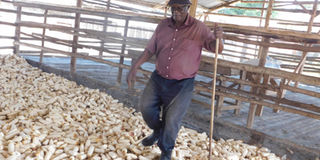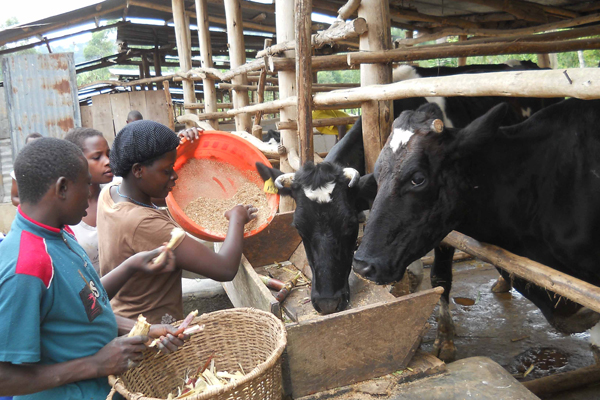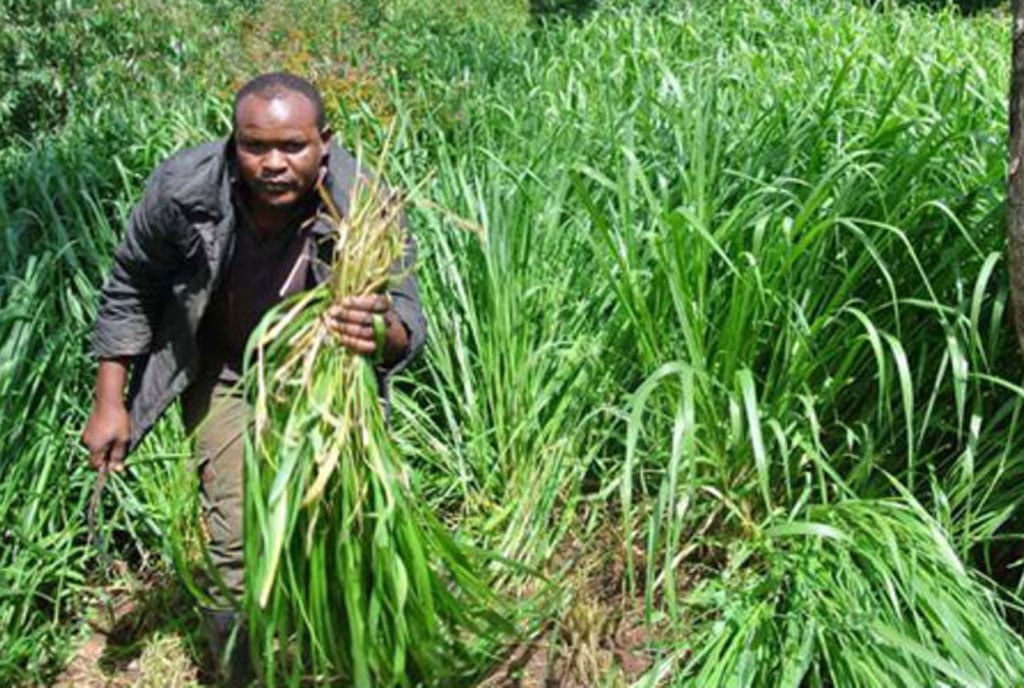Prime
Be careful with what you feed your livestock

Gerald Sendaula inspects part of his maize harvest inside the store at his farm. Photos | Michael J Ssali
What you need to know:
- To maximise farmer’s earnings from livestock keeping it is very important to take very good care of the animals and birds. If the animals and birds are not well fed their yields decrease.
Farmers keep livestock for a purpose. Chicken, ducks, and other birds are kept for their eggs and meat while cattle, goats, and other animals are kept for their milk and meat.
Livestock is human food, a good source of income, and many health benefits. Farmers also earn money from the sale of by-products, such as livestock dung, skins, and hides. Many farmers use livestock dung and urine as manure in their gardens to increase crop production.
Observe good hygiene on farm
To maximise farmer’s earnings from livestock keeping it is very important to take very good care of the animals and birds. If the animals and birds are not well fed their yields decrease. The quality and amount of their by-products will also decline if the feeding is not right. They may fall sick and even die as a result of poor feeding. Dr Paul Kanoonya, retired Masaka District Production Officer, has told Seeds of Gold that it must be born in mind that the animals and birds which the farmers keep today in their homes for meat, milk and eggs once lived on their own in the wild, finding their food and sleeping wherever they found fit.
“Today man has domesticated them and it is his responsibility to feed them and to house them for his own benefit,” he says. “Not all farmers however really understand the importance of observing good hygiene when feeding them. Many do not even know that the animals and birds require appropriate housing. Yet failure to feed them on hygienic food and to provide them with proper housing has a strong bearing on their health and production rate and, ultimately, on the farmer’s income,” says Dr Kanoonya.
Proper way of feeding
Dr Kanoonya particularly warns farmers against feeding their animals on maize and other plant products that have attracted the formation of fungi on them. He further says that fungi produce chemicals which are toxic to both man and animals. He went on to say that fungi are also responsible for producing a highly poisonous compound called aflatoxin. Grain which is kept in moist conditions and has developed fungi or any feed material of plant origin like banana peelings with signs of mould must not be given to livestock to eat. “When livestock is fed on feeds that are infested with fungus or bacteria it can result in the animals developing diarrhea and getting dehydrated and anaemic,” he says. “Pregnant animals may even abort due to dehydration and anaemia.”
Poor housing
He further says that some animals such as pigs develop diseases as a result of poor housing. According to him pigs are very clean animals by nature and don’t want to defecate where they lie to rest or where their food is. However because they are prisoners in badly constructed housing often their droppings and urine get mixed with their food which when eaten results in bacterial infection. Kanoonya advises all farmers to be in regular contact with their area agricultural services extension officers for guidance on animal housing construction and feeding of their animals and birds.
Poison in animal feeds
He goes on to warn farmers about the poison in cassava. He says farmers must take extreme care before giving raw cassava or even cassava peelings to livestock because often the peelings naturally carry a highly toxic substance called cyanide. He advises farmers to detoxify cassava always by soaking, drying and scraping before giving it to animals.

People feed animals in Uganda.
“Consumption of the meat of diseased or poisoned animals is absolutely forbidden because it can transfer the danger to those who eat the meat,” Kanoonya said. He also said that when farmers fail to purchase what he called the animal salt block and make it available to the animals, they tend to look for the minerals contained in the blocks by scratching and scavenging the ground in search for the minerals and in the process get exposed to anthrax which is a very dangerous and fast killing germ. The animal dies quickly and if humans eat its meat they risk dying too.
Dont feed chicken grain with aflatoxins
Aidan Kamugisha, a large scale poultry farmer in Masaka City, also says that any grain infested with aflatoxins or is mouldy must never be used to make chicken feed. “In the first place the farmers must observe all safe maize post-harvesting practices,” he says. “Some farmers misuse pesticides to protect their maize from pest attack. Some pesticides are actually poisons and if they get mixed with the feeds they can cause sickness or even death to the animals and birds.” Dr Robert Alex Isabirye, a specialist in animal health and nutrition, at Mukono Zonal Agricultural Research Development Institute (MUZARDI) Kamenyamiggo Satellite, says due to poor storage of grain like soya bean and maize aflatoxins develop and consumption of aflatoxins by livestock causes slow growth, illness, and infertility. “The farmer then loses money buying vitamins and medicines hoping to alleviate the problem but it reduces his profit margin,” says Isabirye. “Aflatoxins also lower livestock’s immunity to diseases. Slaughtering such animals which are on medication is not recommended because butchers are not allowed by law to stock meat of sick animals.”
Proper storage
He appeals to farmers to desist from storing grain in moist conditions that lead to mould and formation of fungi which result in aflatoxins. Grain that is not fit for human consumption is also not fit for livestock feeding, he says.
He further discloses that aflatoxins consumed in feeds by livestock are also a public health problem because they find their way to livestock products like eggs, milk and meat. He says that when humans consume the products containing aflatoxins they develop kidney and liver issues often leading to death. He goes on to mention adulteration of feeds as another big problem. “Some dishonest feed makers add sand and pebbles deliberately to mukene fish and shell powder which are some of the key components of livestock feed. When the farmer is advised to mix, say 22 kilogrammes of mukene and shell meal with so many maize brand kilogrammes, the diet fed to livestock will not be really complete because perhaps 10 kilogrammes of the mixture will be sand or pebbles which have no nutritive value. The farmer will be hoodwinked into thinking that he is feeding his birds and animals well and yet he will not be seeing any good results,” says Isabirye.
Advice
Isabirye goes on to mention another dangerous bacterium linked to carelessly prepared feeds. It is the salomonella enterica which reduces milk and eggs production, abortion, sickness, and death of livestock. He said even consumption of the meat of the dead animal is prohibited because it can lead to death of the consumer.
Some causes of livestock diseases are generally well known to the farmer. All livestock drink water as part of their diet.
Taking animals to pools of contaminated water for drinking can be a cause of sickness. Parasites such as worms may enter the animal’s digestive system especially if the water contains animal excreta.
Farmers are advised to isolate their animals from infected ones and to disinfect all people and vehicles that go to their farms by making them pass through disinfectant solution. Farmers must guard against such parasites as ticks, tsetse fly and worms.
Poor storage
Farmers should desist from storing grain in moist conditions that lead to mould and formation of fungi which result in aflatoxins. Grain that is not fit for human consumption is also not fit for livestock feeding.
Aflatoxins
Aidan Kamugisha, a large scale poultry farmer in Masaka City, says that any grain infested with aflatoxins or is mouldy must never be used to make chicken feed. “In the first place the farmers must observe all safe maize post-harvesting practices,” he says.




